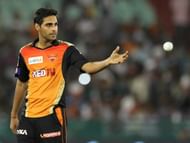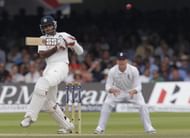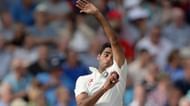The selectors initially picked a 15 man squad to represent India in the 3 Test series against Sri Lanka. 14 of the 15 players got an opportunity to don the whites for India at least once in the series. The one to miss out, the one to carry the drinks entire series was the 25-year-old Bhuvneshwar Kumar.
India went in with 5 specialist bowlers for the first Test at Galle. Varun Aaron with a career bowling average of nearly 20 more than Bhuvneshwar found a place in the playing eleven. So did Harbhajan Singh, who averaged over 40 in his last 19 Tests prior to that match. Both Aaron and Harbhajan were dropped from the side after the Galle debacle but with other alternatives replacing the pair, the door remained shut for the reticent pacer from Uttar Pradesh.
The conundrum of India’s Number ‘3’ is still very much on despite a magnificent ton from Cheteshwar Pujara in the final Test at the SSC in Colombo. Most of the cricketing public seems to be voting unanimously for Pujara – more than 75% of the votes polled on ESPNCricinfo’s online poll as on 8th September, is in favour of Pujara batting at ‘3’. The Virat Kohli- Ravi Shastri partnership though might still be keen on playing Rohit Sharma or Ajinkya Rahane at that position in the upcoming series against South Africa.
It is probably safe to say that we haven’t heard the last on this issue. Interestingly, the fortunes of Bhuvneshwar Kumar have just about mirrored Pujara’s in the last 18 months or so. The way they have been treated by the team management – similar too. Kumar’s demeanour is not too different from Pujara’s either: a pair of shy, circumspect cricketers.
Rewind your clocks to July 2014 and you find that Cheteshwar Pujara and Bhuvneshwar Kumar are India’s rising Test stars heading into a 5-Test series in England. Bhuvneshwar has an outstanding first two matches while Pujara is just above average. What follows is a bitter slump in the next 3 Tests.
India’s next test assignment is against Australia in their own backyard. The tour goes on to become the breaking point for both – for Pujara, due to a sequence of mediocre scores and for Bhuvneshwar, with an injury.
In a bid to get back the number ‘3’ slot, Pujara goes to county cricket to represent Yorkshire and picks up a half century and an unbeaten century in 6 innings. Having played just one game for India at the 2015 World Cup against U.A.E., Bhuvneshwar targets the IPL as a platform to make his way back to the Indian team and emerges as one of the top wicket-takers of IPL 2015.
Both are ready to prove their worth at the Test level in the series against Sri Lanka, but they aren’t part of the team’s plans for the first Two tests. Neither were they given a look in for the one-off Test against Bangladesh prior to this series. It doesn’t quite help to be calm and introverted in the Kohli-Shastri regime, does it?
An astounding comeback post injury
To make a comeback after injury needs a lot of mental resilience. More so, if you are a fast bowler. And more so, if you are as fragile-looking as Bhuvneshwar is. History suggests that much better-built Indian seamers have faded away into oblivion after an injury. The 25-year-old from Meerut could have easily been an addition to that long list of Indian bowlers when he suffered an injury last year. The right-arm bowler, though, had it in him to buck the trend.
The format you least want to make your comeback in as a bowler is T20, but Kumar was left with no choice – the IPL had to be the stage. Bhuvneshwar finished the season with 18 wickets at a decent economy rate. He ended up being the best bowler for the Hyderabad outfit which also had the services of Dale Steyn, Ishant Sharma, Trent Boult and Praveen Kumar. To outperform bowlers of such pedigree, would have taken a lot of effort.
On the tour to Zimbabwe, Bhuvneshwar Kumar was key to India’s success in most games. He defended ten runs in the final over to give India a narrow win in the ODI series opener at Harare. His figures of 4/33 in 10 overs ensured India defended 271 in the next game. In the final match, Kumar went wicket-less but went for a mere 12 runs in 6 overs.
Bhuvneshwar Kumar v/s Stuart Binny
In the final two Test matches of the Sri Lanka series, India abandoned the 5 genuine bowlers theory by picking Stuart Binny. The idea was to have a player who contributes a bit with the bat in the lower order and also gives some control with the ball as the 3rd seaming option after Ishant Sharma and Umesh Yadav.
Ian Chappell made it clear when India picked Binny in their test eleven last year in England that in his opinion, Binny is only a bits and pieces cricketer. Binny’s numbers after 5 Test matches validate Chappell’s statement. Can’t Bhuvneshwar Kumar do a better job in Binny’s place? The numbers tell a story.
| Player | Batting average | Bowling average |
| Bhuvneshwar Kumar | 26.20 | 35.00 |
| Stuart Binny | 21.55 | 85.66 |
Bhuvneshwar has a better batting average than Binny and there is a difference of a country mile in the bowling averages. His 38 off 97 balls in the first Test at Chennai in 2013 against Australia allowed MS Dhoni to compile a double hundred at the other end. The partnership between Kumar and Dhoni sealed the deal for India. Bhuvneshwar’s scores in the first two matches in England last summer read: 58, 63 n.o., 36 and 52. The 36 and 52 came on a green-top at Lord’s. In the last test Bhuvneshwar played, apparently with an injury, he made an unbeaten 20 and 30 in the Sydney Test earlier this year.
In comparison, Stuart Binny just has two notable performances with the bat. A 78 at Trent Bridge last year and a 49 at the SSC recently. If someone argues that the Test careers of these two are relatively short and might not make for a reasonable sample size, then let’s explore their numbers at the first class level. Bhuvneshwar Kumar has 178 wickets from 58 matches while Binny has 100 scalps from 65 games. Binny averages 34 with the bat whereas Bhuvneshwar averages 29.48, a close call.
Bhuvneshwar gives you control
Beyond statistics, India are in need of a medium pace bowler who can give some control when the ball is slightly old and your premier quicks want a break, say in the present case, Ishant and Umesh. Binny showed in the recently concluded series that he has a tendency to drop a ball well short of the good length once every over. It was bread and butter for Angelo Mathews to put them away.
Bhuvneshwar rarely commits these errors. The pitch map on a dead Trentbridge surface last summer tells you a story. Hardly anything short to the batsmen and just a couple of deliveries on the leg stump of the right-handers in a 30.5 over bowling effort. That is control.
The 2015 Ashes revealed how badly Michael Clarke missed Ryan Harris. Despite having the services of Mitchell Starc, Josh Hazlewood, and the others, Clarke missed the ‘control’ bowler. In effect, his strike bowler in Mitchell Johnson had to do both the roles – the wicket-taking one and the holding job.
I am not suggesting that Bhuvneshwar is in the Ryan Harris league. He certainly isn’t, but Kohli will need a steady seamer against good batting oppositions. Binny certainly doesn’t fit such a role. Umesh Yadav has to be used in short bursts and Ishant certainly can’t bowl all day. To expect Ashwin to keep running through batting line-ups in every Test match is also taking the argument a little beyond the realms of reality. South Africa’s batsmen might not surrender as easily as Sri Lanka’s batsmen did recently.
Bhuvaneshwar outshine’s India’s other fast-bowlers
| Player | Average | Strike rate | Economy |
|---|---|---|---|
| Umesh Yadav | 38.56 | 53.6 | 4.31 |
| Bhuvneshwar Kumar | 35.00 | 65.9 | 3.18 |
| Varun Aaron | 54.68 | 66.8 | 4.91 |
| Mohammed Shami | 36.14 | 57.0 | 3.80 |
Bhuvneshwar Kumar has the best bowling average and economy rate in comparison to his counterparts listed above. Even without taking into account Bhuvneshwar’s batting abilities, he must walk into the side if India decides to play 3 specialist pace options. Ishant Sharma is at the top of his game and is an automatic selection. Varun Aaron is far from Test match material. Yes, he has pace, but hardly hits the right areas to trouble good batsmen.
A fully fit Mohammed Shami will put Umesh Yadav’s spot in the team as the second seamer under the scanner. Shami is just as quick as Yadav is and his attribute of reversing the old ball might make him a better option than Yadav. On a seamer friendly surface at the SSC in Colombo, Yadav was arguably the least impressive bowler on show in a four-way race between him, Ishant Sharma, Dhammika Prasad and Nuwan Pradeep.
He recorded figures of 1/64 and 2/65 in the game where Ishant and Prasad bagged 8 wickets each and Pradeep picked up 5 wickets. That leaves behind a very capable Bhuvneshwar to take the 3rd spot available.
Efficacy with the old ball
Bhuvneshwar’s performances with the old ball have attracted significant criticism in his short career. There is a lot of merit in that, but the question is how many Indian bowlers who play ahead of Bhuvneshwar in the eleven are as good with the old ball as the new one? Are Umesh Yadav and Varun Aaron so efficient with the older ball? Probably not.
And you can’t judge every facet of Bhuvneshar Kumar in just 12 Tests. India knows that well. Ishant had the 2nd worst average ever after 50 Test matches in his career. Yet, India stuck with him and the decision is paying off now. Why don’t they give Bhuvneshwar an extended run in this case? Especially when he has shown the quality to work on his weaknesses.
When he first burst onto the scene in limited overs cricket, Kumar was exceptional with the new ball. MS Dhoni often made him bowl as many as 8 overs in his first spell. Dhoni was right in assessing Kumar’s limitation as a death bowler in ODI cricket. A 128 kph bowler bowling good length stuff at the death is a lucrative scoring option for batsmen. Bhuvneshwar had to work on this aspect of his game and he did precisely that.
Bhuvneshwar’s improvement in his death bowling was so impressive that this is what Tom Moody, coach of the Hyderabad IPL team had to say earlier this year: "His discipline at the death overs has been second to none. He is up there with some of the best death bowlers that have been playing this year. He has got his yorkers in and the use of the timing of his slower ball has been very impressive. We are very lucky to have him."
If given an opportunity, it might just be a matter of time that Bhuvneshwar Kumar converts himself into a complete Test bowler.
Way back into the team
Cheteshwar Pujara got a chance to play in the third Test against Sri Lanka since India were without the services of Murali Vijay and Shikhar Dhawan for the final Test and made the opportunity count with a Man of the Match performance. Bhuvneshwar might well get his chance at Mohali in the series opener against South Africa next month because India would be without the services of Ishant Sharma.
To be honest, it’s a pity that players like Pujara and Bhuvneshwar get an opportunity to play merely because of injuries or poor behaviour of counterparts rather than being picked for their better cricketing skills.
The Indian team management seems to be judging players similar to ‘books by their covers’. Rohit Sharma’s elegant off drive and Varun Aaron’s pace are those tempting book covers. Test matches are not won on a couple of jaw-dropping shots or bowling at 145 kph. Test matches are won by hundreds such as Pujara’s at the SSC and spells such as Bhuvneshwar’s last year at the home of cricket.
Brand-new app in a brand-new avatar! Download CricRocket for fast cricket scores, rocket flicks, super notifications and much more! 🚀☄️



